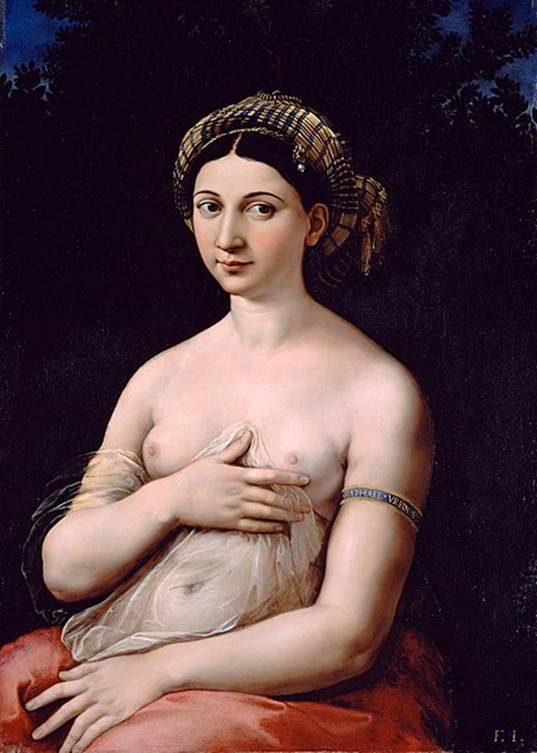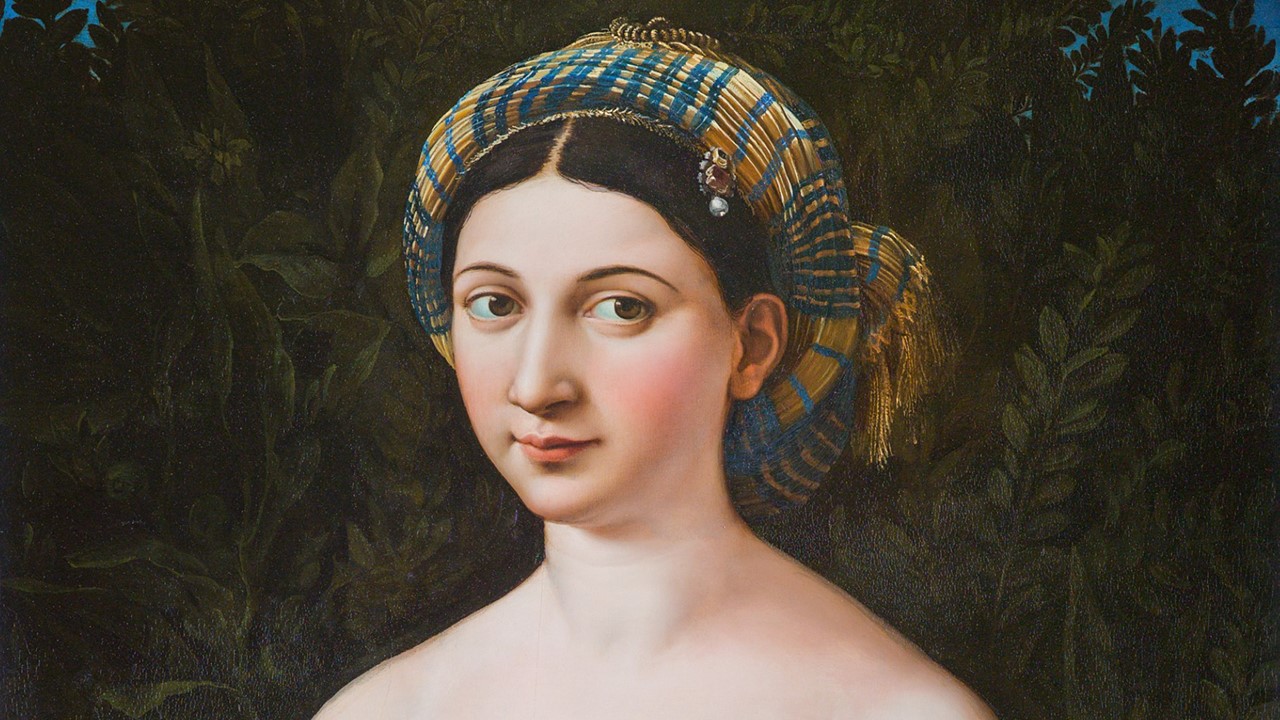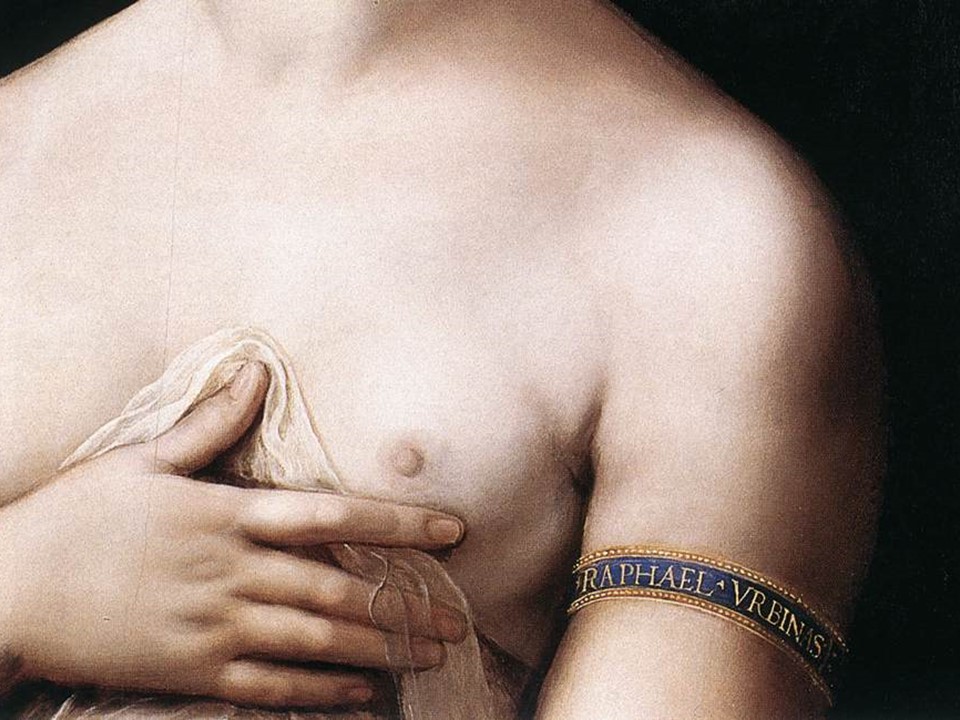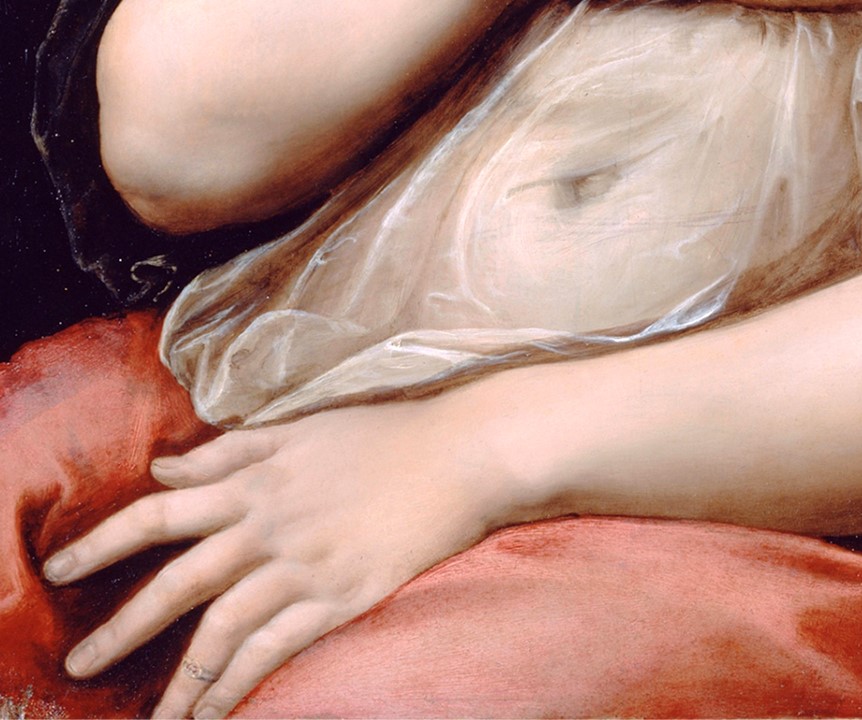
Portrait of a Woman – La Fornarina, about 1519–20, Oil on Panel, 85×60 cm, Galleria Nazionale di Arte Antica (GNAA), Palazzo Barberini, Rome, Italy
https://el.wikipedia.org/wiki/%CE%91%CF%81%CF%87%CE%B5%CE%AF%CE%BF:La_Fornarina,_por_Rafael.jpg
The life of Raffaello Sanzio da Urbino was short, his work prolific, and his legacy immortal. This is how the National Gallery in London experts introduce their audience to the blockbuster Credit Suisse Exhibition on Raphael (9 April – 31 July 2022)… But I want to return to Giogio Vasari… The liberality with which Heaven now and again unites in one person the inexhaustible riches of its treasures and all those graces and rare gifts which are usually shared among many over a long period is seen in Raphael Sanzio of Urbino, who was as excellent as gracious and endowed with a natural modesty and goodness sometimes seen in those who possess to an unusual degree a humane and gentle nature adorned with affability and good-fellowship, and he always showed himself sweet and pleasant with persons of every degree and in all circumstances… and take another look at La Fornarina… http://www.artist-biography.info/artist/raphael/ and https://www.nationalgallery.org.uk/exhibitions/the-credit-suisse-exhibition-raphael#content
Ever since I saw La Fornarina at Palazzo Barberini in Rome, I was intrigued by its captivating beauty and mysteries. Who is the beautiful woman who modestly tries to cover herself?

Portrait of a Woman – La Fornarina (detail of the face), about 1519–20, Oil on Panel, 85×60 cm, Galleria Nazionale di Arte Antica (GNAA), Palazzo Barberini, Rome, Italy
Foto di Mauro Cohen https://www.nationalgallery.org.uk/exhibitions/the-credit-suisse-exhibition-raphael/a-brief-introduction-to-raphaels-life-and-times
Giorgio Vasari describes Raphael as a very amorous man, fond of women, …always swift to serve them. This description “helps” Raphael enthusiasts identify the woman portrayed in La Fornarina with Margherita Luti, Raphael’s Roman lover, the daughter of a baker in Trastevere. Unfortunately, there is no description or record of such a painting created by the artist at the time. There are, however, “hints” that supporters of this interpretation like to consider. For example, her right-hand rests, gently, over her heart, holding her exposed breast. More so, her left hand, the hand of the heart, is adorned with a luxurious armband bearing the inscription “Raphael Urbinas,” the painter’s signature and her fourth finger is adorned with a ruby wedding ring, hidden under flesh-coloured paint for almost five centuries, and revealed in 2001 when an x-ray analysis was carried out on the painting. According to primary sources, Raphael died a young, unmarried man of 37, engaged at the time to a woman named Maria Bibbiena, the daughter of his patron Bernardo Dovizi. Could La Fornarina truly be the portrait of Margherita? There are “hints” but no evidence… https://www.barberinicorsini.org/en/opera/la-fornarina/ and http://www.artist-biography.info/artist/raphael/ and https://www.walksofitaly.com/blog/art-culture/art-history-mystery-la-fornarina-raphael

Portrait of a Woman – La Fornarina (detail), about 1519–20, Oil on Panel, 85×60 cm, Galleria Nazionale di Arte, Palazzo Barberini, Rome, Italy
https://commons.wikimedia.org/wiki/File:Fornarina_03.jpg
Then come the Palazzo Barberini experts who have a different “reading” on the identity of the elusive young woman… They suggest that Raphael’s female Portrait in their Collection presents no other than Goddess Venus. The position of her hand, for example, one placed on her lap and the other on her breast, follows the classic statuary model of the “Venus Pudica”: a gesture of modesty that yet directs the viewer’s gaze to what she actually seeks to conceal. Other symbols are to be found in the painting’s background… the myrtle bush, laurel, and branches of quince are sacred emblems of Venus, marriage, lust, and fertility. Plausible but not decisive… https://www.barberinicorsini.org/en/opera/la-fornarina/

Portrait of a Woman – La Fornarina (detail), about 1519–20, Oil on Panel, 85×60 cm, Galleria Nazionale di Arte, Palazzo Barberini, Rome, Italy
https://claudiaviggiani.com/fornarina-di-raffaello-in-palazzo-barberini/
Finally, I enjoyed reading Rona Goffen’s article on Raphael’s Designer Labels: From the Virgin Mary to La Fornarina (Artibus et Historiae Vol. 24, No. 48, 2003). pp. 132-135). Raphael, the author believes, tantalized, and still tantalizes his audience with clues to the woman’s identity but withholds her name. Whatever La Fornarina’s real name might have been, the author concludes, whatever (personal amorous) considerations might have motivated Raphael, he painted her portrait as the embodiment of the beauty of his art, that is, not universal, but idiosyncratic, individual, unmistakable for any other. Redefining beauty according to his own criteria, asserting his possession of her, whose image he created, Raphael asserted possession of art itself. And so Raphael signed the Fornarina without a date, because his possession is forever, his achievement immortal. This is an article worth reading! https://www.jstor.org/stable/1483734?read-now=1&refreqid=excelsior%3A2d02ae94d96f8d5167a5b6a3fb35f281&seq=13#page_scan_tab_contents pp. 132-135
For a PowerPoint on Raphael’s Portraits of Women, please… Check HERE!